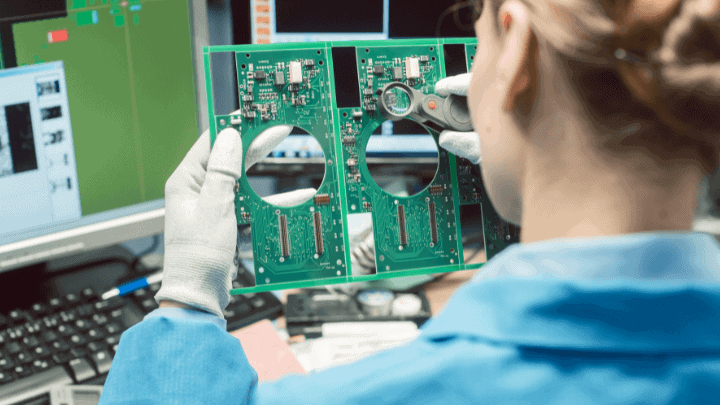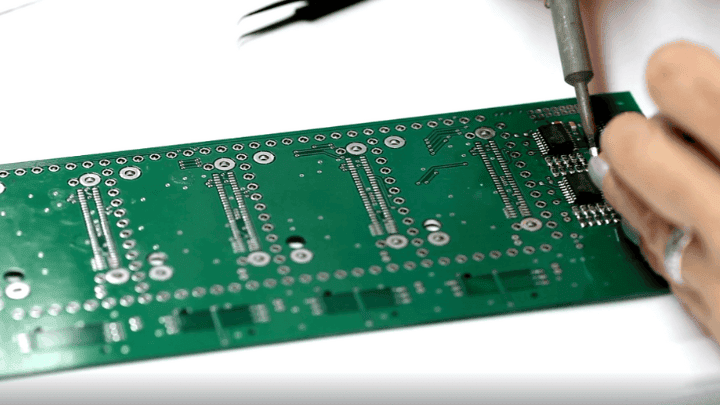How Contract PCB Assembly Streamlines Your Electronics Journey
Introduction
Imagine this: you’ve poured your heart and soul into designing the next groundbreaking electronic gadget. The schematics are flawless, the components meticulously chosen. But then reality sets in – transforming your brilliant concept into a tangible product requires navigating the complexities of PCB assembly. Here’s where the magic of contract PCB assembly steps in, ready to breathe life into your creation and propel it towards production.
Whether you’re a seasoned engineer or a budding entrepreneur with a game-changing idea, this guide is your one-stop shop for understanding the ins and outs of contract PCB assembly. We’ll delve into the intricacies of the process, unveil the undeniable benefits it offers, and equip you with the knowledge to select the perfect partner for your project. So, buckle up and get ready to unlock the door to streamlined production and exceptional quality control – all within the realm of contract PCB assembly!
What is Contract PCB Assembly?
The brainchild of your innovation comes alive through the marvel of PCB assembly. But what exactly does this process entail? Picture a meticulously crafted dance – bare PCBs gracefully waltzing through various stations, each adding its unique touch to transform them into functional marvels. Here’s a breakdown of the key steps involved:
- Surface Mount Technology (SMT): Miniaturized components are precisely placed onto the PCB surface using high-speed pick and place machines. Imagine tiny robots with laser focus, meticulously positioning each component with incredible accuracy.
- Through-Hole Technology (THT): Leads of these components are inserted into pre-drilled holes on the PCB, and then securely soldered to form strong electrical connections. Think of it as building a tiny bridge between the component and the PCB using molten solder.
- Soldering: Molten solder forms the heart of the connection between components and the PCB. This process can be achieved through various techniques, including wave soldering and reflow soldering, each ensuring a reliable and permanent bond.
- Rigorous Testing: Just like putting your creation through its paces, assembled PCBs undergo a battery of electrical and functional tests. This ensures every board meets the predefined specifications and performs flawlessly before reaching your hands.

Where Does Contract PCB Assembly Fit In?
While the PCB assembly process might seem captivating, the reality is that for many companies, venturing into in-house assembly might not be the most strategic move. This is where contract PCB assembly comes to the rescue. Imagine a team of experts, armed with cutting-edge technology and years of experience, ready to shoulder the responsibility of transforming your PCB design into a flawlessly assembled product. Companies choose to outsource PCB assembly for several compelling reasons:
- Cost-Effectiveness: Contract manufacturers leverage economies of scale and their established buying power to secure components at competitive rates. This translates to significant cost savings for you, freeing up valuable resources to invest in other aspects of your project.
- Unparalleled Expertise: Contract manufacturers are seasoned professionals with a deep understanding of the intricacies of PCB assembly. They possess the technical know-how and utilize state-of-the-art equipment to deliver exceptional quality and consistent results. Think of them as PCB assembly ninjas, possessing the skills and tools to tackle even the most challenging projects.
The Benefits of Contract PCB Assembly
Imagine this: you’re racing against the clock to get your innovative product to market. In-house PCB assembly might seem like a viable option, but it can often lead to bottlenecks and delayed timelines. This is where contract PCB assembly swoops in, offering a multitude of benefits that can supercharge your project’s success. Let’s delve into the three key advantages that make contract PCB assembly an attractive proposition:
Enhanced Efficiency and Speed:
- Free Up Internal Resources: In-house PCB assembly requires dedicating manpower and resources to manage the entire process, from handling a wide range of PCB specifications like minimum board size of 50 millimeters by 50 millimeters and a maximum size of 510 millimeters by 460 millimeters, to ensuring components as small as 01005 chip packages and 0.35 pitch BGAs are placed with an accuracy of +/- 0.04 millimeters. By outsourcing, your team can focus on their core competencies, like product design and marketing. This allows for a more streamlined workflow and faster time-to-market.
- Streamlined Production: Contract manufacturers boast established production lines and optimized workflows capable of handling a high volume of boards. For instance, some manufacturers boast a capacity of 5 million SMT assembly points per day and 300,000 through-hole assembly points per day. This translates to faster turnaround times, ensuring your PCBs move swiftly from design concept to finished product. Imagine slashing weeks, or even months, off your development cycle!
Superior Quality Contro
- Rigorous Quality Standards: Experienced contract manufacturers adhere to stringent quality control protocols throughout the entire assembly process. This includes employing advanced inspection techniques like Automated Solder Paste Inspection (SPI) and Automated Optical Inspection (AOI) to minimize errors and ensure consistent performance. They can also handle complex components like Ball Grid Arrays (BGAs) and Quad Flat No-Lead (QFN) packages using X-Ray inspection.
- Reduced Risk of Defects: In-house assembly might expose your project to potential quality issues due to a lack of specialized equipment or expertise. Contract manufacturers, on the other hand, have the arsenal necessary to identify and rectify problems early on, leading to a significant reduction in defective boards. They can even provide full sets of substitute materials to ensure cost-effectiveness without compromising quality.

Cost Optimization
- Economies of Scale: Contract manufacturers leverage their buying power and established supplier relationships to secure components at competitive rates. This translates to significant cost savings for you, freeing up valuable resources to invest in other aspects of your project. Some manufacturers even offer services like component sourcing and management, further streamlining your procurement process.
- Reduced Overhead Costs: Maintaining an in-house PCB assembly line requires investment in equipment, training, and floor space. By outsourcing, you eliminate these ongoing costs and only pay for the services you need. This can be a significant advantage for startups and companies with limited resources.
Beyond Efficiency and Cost Savings
The advantages of contract PCB assembly extend far beyond just streamlining production and saving money. Here are some additional benefits to consider:
- Scalability: Contract manufacturers can easily scale their production capacity to meet your evolving needs. This is particularly beneficial for companies with fluctuating production volumes or those launching new products.
- Access to Expertise: Contract manufacturers possess a wealth of knowledge and experience in PCB assembly. They can provide valuable insights into design optimization, material selection, and best practices, ultimately leading to a higher quality product.
- Reduced Risk: Outsourcing PCB assembly mitigates the risks associated with managing an in-house production line. This includes the risk of equipment malfunctions, component shortages, and unexpected quality issues.
By partnering with a reputable contract PCB assembly manufacturer, you gain access to a team of experts who can transform your vision into a reality. They’ll handle the complexities of the assembly process, freeing you to focus on what you do best – innovation!
Contract PCB Assembly Considerations
While the benefits of contract PCB assembly are undeniable, it’s crucial to approach the process strategically to ensure a smooth and successful collaboration. Here are some key considerations to keep in mind
Prototype vs. High-Volume Production:
- Prototype Needs: During the prototyping stage, your primary focus might be on functionality and design verification. You may require smaller batches with a quicker turnaround time to test and refine your concept.
- Contract Manufacturer Capabilities: Many contract manufacturers cater specifically to prototyping needs by offering small batch production runs with fast lead times, sometimes as quick as 12 hours. They may also provide design for manufacturability (DFM) feedback to help optimize your PCB design for assembly.
Bill of Materials (BOM) Management:
- BOM Accuracy is Paramount: A Bill of Materials (BOM) is a comprehensive list of all components required for your PCB assembly. This document serves as the blueprint for the contract manufacturer, so ensuring its accuracy is critical for both quoting and assembly.
- Collaboration is Key: Work closely with your chosen contract manufacturer to review your BOM. They can provide valuable insights into component availability, potential lead times, and even suggest cost-effective alternatives. A clear and collaborative approach to BOM management sets the stage for a successful partnership.
Finding the Right Contract PCB Assembly Partner
- PCB Specifications Capability: Not all contract manufacturers possess the capability to handle every type of PCB specification. Ensure the manufacturer you choose can accommodate your specific needs. This includes factors like minimum board size, maximum board size, board thickness, and component complexity. For instance, some manufacturers might specialize in high-density PCBs with intricate components like 0.1mm pitch BGAs, while others might focus on larger, simpler boards.
- Production Lead Time: Lead time refers to the time it takes for a contract manufacturer to complete your order. Consider your production schedule and choose a manufacturer that can meet your delivery time requirements. As mentioned earlier, some manufacturers offer expedited services with lead times as fast as 24 hours for prototypes, while others cater to high-volume production with lead times of several days.
Table: Contract PCB Assembly Capability Comparison
| Feature | Capability | Description |
|---|---|---|
| Minimum Board Size | L50mm x W50mm | This is the smallest board size the manufacturer can handle. |
| Maximum Board Size | L510mm x W460mm | This is the largest board size the manufacturer can handle. |
| Minimum Board Thickness | 0.2mm | This is the thinnest board the manufacturer can assemble. |
| Maximum Board Thickness | 3.0mm | This is the thickest board the manufacturer can assemble. |
| Assembly Type | FR4, FPC, Rigid-Flex PCB, Metal Base PCB | The types of PCBs the manufacturer can assemble. |
| Components | 01005 Chip / 0.35 Pitch BGA | The smallest and most complex components the manufacturer can handle. |
| SMT Assembly Capacity | 5 Million Points/Day | The number of SMT placement points the manufacturer can handle per day. |
| Through-Hole Assembly Capacity | 300,000 Points/Day | The number of through-hole placement points the manufacturer can handle per day. |
Additional Considerations:
- Assembly Line Capabilities: Inquire about the manufacturer’s assembly line capabilities. Do they have dedicated lines for prototypes or high-volume production? What type of testing procedures do they employ? Understanding their infrastructure can give you valuable insight into their efficiency and quality control measures.
- PCB Cost: Contract PCB assembly costs can vary depending on several factors, including board complexity, component selection, and volume. Obtain quotes from multiple manufacturers to compare pricing and ensure you’re getting a competitive rate.
By carefully considering these factors, you can select a contract PCB assembly partner who possesses the expertise and capabilities to meet your specific needs and ensure a successful project. In the next section, we’ll delve into some advanced contract PCB assembly services that can further enhance your project’s potential!
Beyond the Basics: Advanced Contract PCB Assembly Services
The world of contract PCB assembly extends far beyond the standard assembly process. For those seeking a truly comprehensive solution, a range of advanced services can elevate your project to new heights. Let’s explore some of these cutting-edge offerings:
Turnkey Solutions
- Streamlined Efficiency: Imagine a single point of contact for your entire PCB journey. Turnkey contract manufacturers provide a one-stop shop, handling everything from design review and schematic capture to component procurement and final assembly. This eliminates the need for multiple vendors and simplifies project management.
- Enhanced Expertise: Turnkey manufacturers boast a team of experienced engineers who can collaborate with you throughout the entire design process. They can offer valuable insights into design for manufacturability (DFM) principles, helping you create PCBs that are not only functional but also optimized for efficient assembly.
New-Age Technologies
- Embracing Innovation: The world of electronics is constantly evolving, and so too are the capabilities of contract PCB assembly. Leading manufacturers embrace new-age technologies to deliver exceptional results. This may include utilizing lead-free soldering compounds that comply with environmental regulations, or incorporating micro BGAs with pitches as fine as 0.1 millimeters for enhanced miniaturization.
- Future-Proofing Your Designs: By partnering with a manufacturer that utilizes advanced technologies, you can ensure your PCBs are built to meet the demands of the future. This can give you a competitive edge and allow you to bring innovative products to market faster.
In-Line Testing and Inspection
- Rigorous Quality Assurance: Contract PCB assembly doesn’t stop at assembly. Leading manufacturers employ rigorous in-line testing and inspection procedures throughout the entire process. This ensures every board meets the predefined specifications and performs flawlessly before reaching your hands.
- A Multi-Pronged Approach: In-line testing may involve Automated Optical Inspection (AOI) to detect placement errors and soldering defects, X-Ray inspection for intricate components like BGAs, and even functional testing to verify the board’s performance against set parameters. This multi-pronged approach minimizes the risk of defective boards and ensures the highest quality possible.
By venturing beyond the basics and exploring these advanced services, you can unlock a world of possibilities for your PCB assembly project. From streamlined efficiency to cutting-edge technologies, contract manufacturers offer the tools and expertise to bring your vision to life.
Contract PCB Assembly FAQs
Now that you’re armed with the knowledge of contract PCB assembly’s potential, you might have some lingering questions. Let’s delve into some frequently asked questions to address any uncertainties:
How much does Contract PCB Assembly cost?
- A Web of Factors: There’s no one-size-fits-all answer to the cost of contract PCB assembly. Several factors influence the final price tag, including:
- Order Volume: Generally, higher order volumes translate to lower per-unit costs due to economies of scale. Prototypes or small batch runs will typically cost more per board compared to high-volume production.
- Board Complexity: The complexity of your PCB design plays a significant role. Boards with intricate features, a high number of layers, or densely packed components will require more time and resources to assemble, leading to higher costs.
- Component Selection: The type and cost of components you choose will directly impact the overall price. Components like high-performance processors or specialized ICs will naturally be more expensive than basic resistors or capacitors.
- Getting a Quote: The best way to determine the exact cost for your project is to obtain quotes from multiple contract PCB manufacturers. Be sure to provide them with detailed information about your PCB design, bill of materials (BOM), and desired turnaround time.
What file formats do contract manufacturers accept?
- Speaking the Language of Manufacturing: To ensure smooth communication and accurate assembly, contract manufacturers rely on specific file formats. Here are some commonly accepted formats:
- Gerber Files: This industry-standard format provides essential information about the layout of copper layers, soldermask, and other critical PCB features.
- Netlists: Netlists define the electrical connectivity between components on your PCB.
- Bill of Materials (BOM): A comprehensive list of all components required for your PCB assembly, including part numbers, quantities, and specifications.
- Double-Check is Always Best: It’s always a good practice to check with your chosen manufacturer about their specific file format requirements. This ensures compatibility and avoids any potential delays in the production process.
What are the lead times for Contract PCB Assembly?
- A Balancing Act: Lead times for contract PCB assembly depend on a delicate balance between order complexity and manufacturer workload. Here’s a breakdown of some factors that can influence lead times:
- Order Complexity: Simple, single-layer PCBs with readily available components will naturally have shorter lead times compared to complex, multi-layer boards with intricate components or custom parts.
- Manufacturer Workload: The current workload of the contract manufacturer will also play a role. If they’re swamped with orders, your lead time might be longer compared to a manufacturer with more available capacity.
- The Art of Planning: Understanding lead times is crucial for effective project planning. Communicate your desired timeline clearly with the manufacturer during the quoting process. Many manufacturers offer expedited services with faster lead times for an additional fee, which can be a valuable option if you’re facing tight deadlines.
By understanding these FAQs, you’re well on your way to navigating the world of contract PCB assembly with confidence. Remember, the key is to choose a reputable manufacturer who possesses the expertise and capabilities to meet your specific needs. With the right partner by your side, you can transform your innovative ideas into reality with exceptional quality and impressive efficiency.
The world of PCB assembly can seem complex, but by partnering with a qualified contract manufacturer, you can unlock a world of benefits. We’ve explored how contract manufacturers offer not only exceptional efficiency and quality control, but also cost-effective solutions and access to cutting-edge technologies. Don’t be afraid to leverage their expertise – from prototype development to high-volume production, they can be your trusted partner in bringing your electronic innovations to life.
Remember, a successful contract PCB assembly partnership hinges on open communication and clear expectations. By carefully considering your needs and collaborating effectively with your chosen manufacturer, you can ensure a smooth and successful journey from concept to completion. So, are you ready to transform your vision into a reality? Look no further than the power of Contract PCB Assembly!



